Editor's Note: Earlier this year, John Stencell notified TI Life that the original Kim Lunman article about Garden Island, written in November 2011, was missing. He was right, and both Kim and I were a wee bit frantic, until John admitted that the island's history had been a subject of his studies while he’d attended Queen's University several decades ago. This editor, being as resourceful as possible, asked John if he would go back to his notes and give us a short version of the island's history. He not only obliged us, but he also supplied several additional resources.
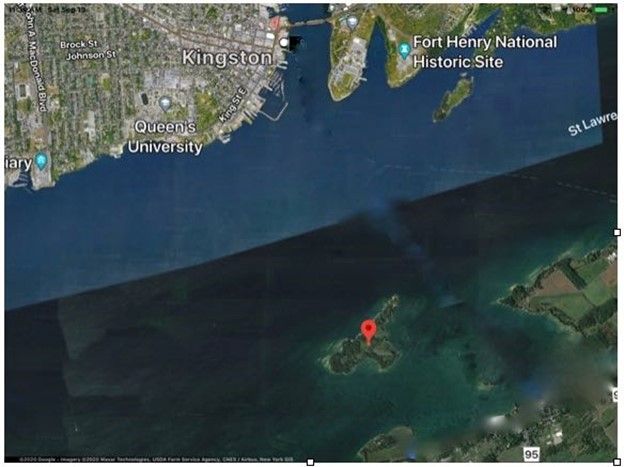
Part of the Garden Island Story
I have included links to additional "short reads", diagrams and pictures.
The first is the link to Wikipedia, which is always a good place to start.
The hero of this story is Delino Dexter Calvin (b. 15 May 1798; d. 18 May 1884)
D.D. Calvin's biography is both interesting and entertaining. He was called the "governor" or the "gov" by his men and was known for tackling any job. In fact, they say Calvin's joy was in doing things, not in making money, and that he spent little on himself.
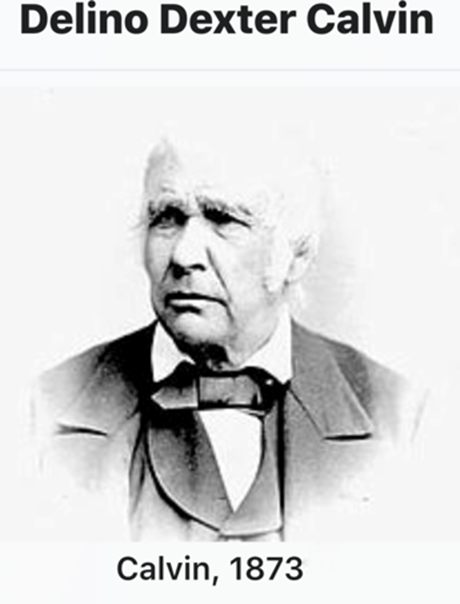
The Calvin Company
There are many aspects to the story: world history, international politics, economics, and means of transport using wooden ships, all of which are a big part of the Garden Island story, beginning in the 1820s. At that time, there was an abundance of giant trees, the likes of which we can only try to imagine today. (Currently, the tallest pine tree in Ontario is in Arnprior and stands 47 meters or 13 stories tall.) This is a story about the timber trade, which replaced the fur trade in Canada's economic development.
Calvin was a fine example of a pioneer man of business in the 1800s. He started a small business in Clayton, NY in 1815. For reasons that remain unrecorded, Calvin concluded that Clayton was not an adequate base for his operations. Consequently, in 1836, he relocated to rented land on the eastern end of Garden Island, which is sixty-five acres in extent and located two miles south of Kingston, ON, in Canada
Calvin's business core was rafting timber and delivering it to the timber coves at Québec City (540 kilometers/330 miles) down the St. Lawrence River. Here the lumber was trans-shipped to British markets.
Being in British territory on Garden Island, Calvin was able to operate within the British trading system. Physically, the island was delightful; geographically, the choice was brilliant. The southeast configuration of the island, with Wolfe Island to the south, provided a sheltered bay that was ideal for disembarking timber, holding it, and building rafts.
Initially, Calvin was dependent on sail, and Garden Island provided safe waters for sailing craft, safer than either Kingston or Clayton, to establish his business. The island's location at the foot of the Great Lakes navigation systems meant that timber could easily be transported throughout the Great Lakes by ship. However, ships with their timber, could not conveniently or economically, be transported down the St. Lawrence River. But timber linked together in a timber raft could easily make the voyage.
The essence of Calvin's timber operation was simple. He maintained a fleet of Lake vessels that transported square timber and staves, chiefly oak and pine, to Garden Island. There the timber was unloaded and built into rafts. This process was a considerable operation.
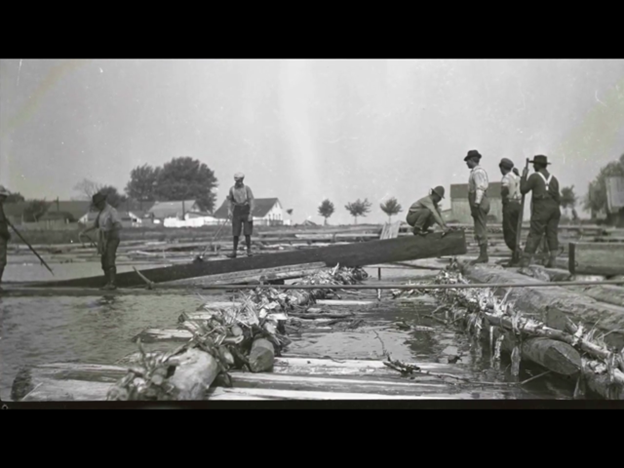
The basic component of a raft was a "dram," which consists of a series of "cribs." A crib was a floating framework, made without bolts or nails, which measured sixty by forty-two feet. Four or five cribs were fastened together to make a dram, which was approximately 250 to 350 feet long. Sticks of timber were then arranged on the cribs and firmly fastened with "withes," which were saplings rendered pliable by being twisted or crushed until they become like rope.
A dozen or more drams made a raft that could be well over a half a mile long and includes 165,000 cubic feet of timber. The St. Lawrence timber rafts even had cooking and sleeping shanties for the raftsmen who would accompany it all the way to Québec City. The raft was broken into its component drams when it passed through rapids. Many considered the raft journey to be an enjoyable adventure. Friends and relatives took the trip from time to time and reported on their exhilarating experiences.
Although Calvin purchased timber for resale and on occasion, financed independent timber makers, the bulk of the timber delivered to Quebec belonged not to Calvin, but to various timber merchants in the Great Lakes basin. It was carried the 350 miles to Québec City for a fee. Therefore, Calvin was shielded from market vicissitudes because he charged his fee regardless of his customers' profit margins.
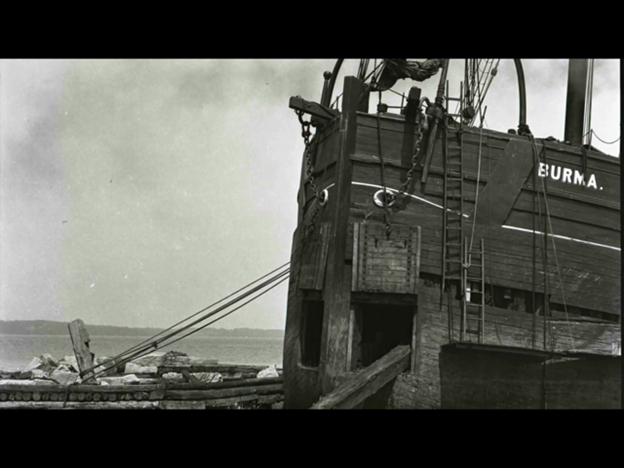
While the essence of Calvin's operations was simple, the logistics and organization were not. The scope of the operation was vast. Until 1854, a branch of the company operated in Hamilton, ON; there was always a branch in Québec City, and agencies were established in various places including Liverpool, England, Glasgow, Scotland, and in the upper Great Lakes, in Sault Ste. Marie, ON, Defiance, OH, and in Marquette, MI.
Twelve to fifteen ships were maintained to deliver timber to Garden Island from as far away as Michigan and Minnesota. Permanent employees lived on Garden Island; during the summer, additional people were employed on the rafts as they passed through difficult portions of the upper St. Lawrence. Initially, the rafts moved only with the aid of the River's current and sails; eventually, they were towed by steam-powered tugboats.
In order to maximize the utility of his investment and to maintain a permanent workforce, Calvin sought other business opportunities. The result was a substantial diversity in the firm's operations. Calvin and his partners operated as general merchants, manufacturers, forwarders, common carriers, wharfingers, warehousemen, ship owners, lumber merchants, wreckers, and rafters. They also rented sheds to store flour, salt, and rails.
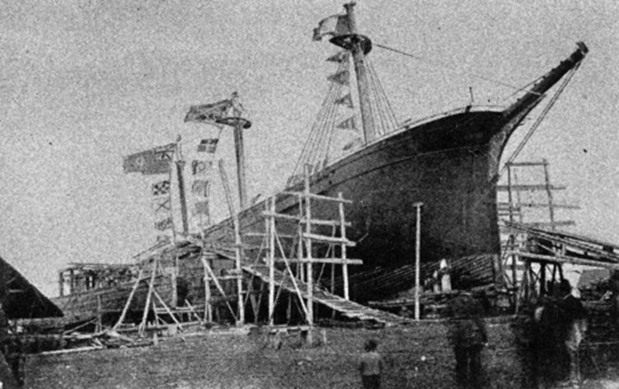
By 1836, the company's shipbuilding enterprise was immense; the company policy was to build a ship a year. The partnership also operated a lucrative government-subsidized tugboat service on the St. Lawrence above Montreal, from 1858 to 1874. In the 1880s, the company had $75,000 invested in its towing and wrecking business alone.
The firm's growth and prosperity are indicated by its assets, which increased from $216,000 in 1854 to $460,000 in 1871. Interestingly enough, the employees shared in this prosperity. Between the 1850s and 1880s, real wages increased by 11%.
In 1865 and other years, Calvin was the largest timber operation in the coves of Québec City; it was also one of the half dozen largest timber firms in Canada. When D.D. Calvin died in 1884; he owned 92% of Calvin and Sons and left an estate conservatively valued at $324,242. $100 in 1884 is equivalent to $2,652.22 today; in other words, his estate would be worth about $8.6M today.
Yes, D. D. Calvin's biography is both interesting and entertaining, and his life's work certainly helped to build British North America. By 1862 he owned all of Garden Island and had built a community. He built housing for his workers and provided stores where they could buy what they needed to care for their families. He also subsidized the school, the library, and the community hall. He was the island's political leader, serving in various roles in the government of the day in Canada West.
In the end the location of the Calvin Company, which was so ideal for dealing with timber transported by water, was not able to adapt to compete with the new mode of transportation, the railroad.
There were many changes in the early 1900s that affected the Calvin Company. First, the expansion of rail transportation impacted the monopoly that water transportation had enjoyed for so long. Second, waterways were dredged and canals were built that allowed larger boats to transport goods further and more efficiently. And finally, the days of the wooden ships came to an end and over time, replaced by steel hulls.
Looking back through history, the timber trade contributed to the successful growth and settlement of our country. However, many wish the trees, which were once so plentiful then, were harvested with greater regard and effort to preserve this precious resource.
Today Garden Island is owned and enjoyed as a summer retreat by descendants of the Calvin family.
_______________________
Other Links
Links to short reads, to provide more personal background about D. D. Calvin, and his brother, Hiram Augustus Calvin, who worked with D. D. Calvin, and who took over the business when D.D. Calvin died. These were written by Professor Donald Swainson of Queen’s University.
http://www.biographi.ca/en/bio/calvin_dileno_dexter_11E.html
http://www.biographi.ca/en/bio/calvin_hiram_augustus_16E.html
Book: A Saga of the St. Lawrence by D. D. Calvin
http://www.transportsourcebook.ca/saga-of-the-st-lawrence/
This is a link to a book written by Hiram Augustus Calvin’s son and D. D. Calvin’s grand-son a prominent Kingston architect. There are many photographs and diagrams. There are also links to two chapters of the book, chapter 6, At the Island and chapter 7, The Last Years.
Article: MR. D.D. CALVIN, A Subject For the Biographer, Career of a Notable Business Man, found on the Maritime History of the Great Lakes webpage. It is a reprint of June 3, 1877 article in the British Whig (Kingston ON)
By John Stencell
John Stencell moved to Kingston in the summer of 1970. John and Helen have two adult children, Gordon and Joanne. They have enjoyed all aspects of the Thousand Island life. And yes, Howe Island residents may remember John and Helen as they taught school on the island for several years.
Posted in: History, Places, Volume 15, Issue 10, October 2020
Please click here if you are unable to post your comment.
